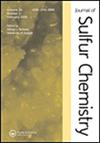Synthesis and characterization of two asymmetrical 2-cyclohexylsulfenyl-5-alkylsulfenyl[1,3,4]thiadiazoles and study the impact of substituents on the structural features, thermal behavior, and anti-bacterial activity
IF 1.6
3区 化学
Q3 CHEMISTRY, MULTIDISCIPLINARY
引用次数: 0
Abstract
Regarding the importance of 1,3,4-thiadiazoles due to versatile biological activity and for investigation of the symmetry impact on thermal behavior and antibacterial activity of 2,5-bisalkylsulfenyl[1,3,4]thiadiazole, two new derivatives viz. 2-cyclohexylsulfenyl-5-cyclopentylsulfenyl[1,3,4]thiadiazole and 2-cyclohexylsulfenyl-5-dodecylsulfenyl[1,3,4]thiadiazole, were synthesized through the nucleophilic substitution reaction appropriate alkyl halide with 5-cyclohexyl-3H-[1,3,4]thiadiazole-2-thione in ethanol under reflux conditions. The chemical structure of the products was elucidated by the physical and spectroscopic techniques. After tedious work, the suitable snow-like crystals of 2-cyclohexylsulfenyl-5-dodecylsulfenyl[1,3,4]thiadiazole for single-crystal X-ray diffraction analysis could be isolated from a mixed solvent, namely ethanol and water in volume ratio of 9:1. Then, the influence of symmetry and cyclic or non-cyclic aliphatic substituents on the important structure parameters of the 2,5-bisalkylsulfenyl[1,3,4]thiadiazole derivatives were negligible, however, those structure characteristics were different for 5–cyclohexylsulfenyl–3H–[1,3,4]thiadiazole–2–thione, due to its thione structure. TGA/DTA study demonstrated the effect of the symmetry and van der Waals interaction on thermal stability, and the robust influence of the pseudo hydrogen bonding NH with C = S on the melting and crystallization phase transitions was revealed by DSC analysis. The pharmacokinetics, drug-likeness, medicinal chemistry friendliness, and toxicology of three derivatives of bis-alkylsulfenyl[1,3,4]thiadiazole were evaluated by two prediction tools of SwissADME and T.E.S.T tools predicted good pharmacokinetics, drug-likeness, and anti-toxicant properties in developmental toxicity for the bis-alkylsulfenyl[1,3,4]thiadiazoles and 5–cyclohexylsulfenyl–3H–[1,3,4]thiadiazole–2–thione. Finally, the in vitro antibacterial activity of two new 2-cyclohexylsulfenyl-5-cyclopentylsulfenyl[1,3,4]thiadiazole and 2-cyclohexylsulfenyl-5-dodecylsulfenyl[1,3,4]thiadiazole against S. aureus and E. coli, confirmed them as promising anti-bacterial agent. All obtained results proved that the physicochemical, thermal, pharmacokinetic, and biological properties of 2,5-bisalkylsulfenyl[1,3,4]thiadiazoles can be tuned by selecting appropriate substituents.
两个不对称2-环己基亚砜基-5-烷基亚砜基[1,3,4]噻二唑的合成与表征,并研究取代基对其结构特征、热行为和抗菌活性的影响
鉴于1,3,4-噻二唑具有广泛的生物活性,并对2,5-双烷基磺酰基[1,3,4]噻二唑的热行为和抗菌活性的对称性影响进行了研究,提出了两个新的衍生物,即2-环己基磺酰基-5-环戊基磺酰基[1,3,4]噻二唑和2-环己基磺酰基-5-十二烷基磺酰基[1,3,4]噻二唑,与5-环己基- 3h -[1,3,4]噻二唑-2-硫酮在乙醇回流条件下通过亲核取代反应合成合适的卤代烷基。通过物理和光谱技术对产物的化学结构进行了分析。经过繁琐的工作,从体积比为9:1的混合溶剂即乙醇和水中分离出适合用于x射线单晶衍射分析的2-环己基磺酰基-5-十二烷基磺酰基[1,3,4]噻二唑的雪状晶体。然后,对称和环状或非环状脂肪取代基对2,5-双烷基磺酰基[1,3,4]噻二唑衍生物的重要结构参数的影响可以忽略不计,而5-环己基磺酰基- 3h -[1,3,4]噻二唑- 2 -硫酮由于其硫酮结构而具有不同的结构特征。热重分析(TGA/DTA)证明了对称和范德华相互作用对热稳定性的影响,DSC分析揭示了C = S的伪氢键NH对熔融和结晶相变的强大影响。采用SwissADME和T.E.S.T两种预测工具对三种双烷基磺酰基[1,3,4]噻二唑衍生物的药代动力学、药物相似性、药物化学友好性和毒理学进行了评价。两种预测工具预测了双烷基磺酰基[1,3,4]噻二唑和5 -环己基磺酰基- 3h -[1,3,4]噻二唑- 2 -硫酮具有良好的药代动力学、药物相似性和抗发育毒性。最后,对两种新型2-环己基磺酰基-5-环戊基磺酰基[1,3,4]噻二唑和2-环己基磺酰基-5-十二烷基磺酰基[1,3,4]噻二唑对金黄色葡萄球菌和大肠杆菌的体外抑菌活性进行了研究,证实了它们是很有前景的抗菌药物。结果表明,2,5-双烷基亚砜基[1,3,4]噻二唑的理化、热、药代动力学和生物学性质可以通过选择合适的取代基来调节。
本文章由计算机程序翻译,如有差异,请以英文原文为准。
求助全文
约1分钟内获得全文
求助全文
来源期刊

Journal of Sulfur Chemistry
CHEMISTRY, MULTIDISCIPLINARY-
CiteScore
4.10
自引率
9.10%
发文量
38
审稿时长
6-12 weeks
期刊介绍:
The Journal of Sulfur Chemistry is an international journal for the dissemination of scientific results in the rapidly expanding realm of sulfur chemistry. The journal publishes high quality reviews, full papers and communications in the following areas: organic and inorganic chemistry, industrial chemistry, materials and polymer chemistry, biological chemistry and interdisciplinary studies directly related to sulfur science.
Papers outlining theoretical, physical, mechanistic or synthetic studies pertaining to sulfur chemistry are welcome. Hence the target audience is made up of academic and industrial chemists with peripheral or focused interests in sulfur chemistry. Manuscripts that truly define the aims of the journal include, but are not limited to, those that offer: a) innovative use of sulfur reagents; b) new synthetic approaches to sulfur-containing biomolecules, materials or organic and organometallic compounds; c) theoretical and physical studies that facilitate the understanding of sulfur structure, bonding or reactivity; d) catalytic, selective, synthetically useful or noteworthy transformations of sulfur containing molecules; e) industrial applications of sulfur chemistry; f) unique sulfur atom or molecule involvement in interfacial phenomena; g) descriptions of solid phase or combinatorial methods involving sulfur containing substrates. Submissions pertaining to related atoms such as selenium and tellurium are also welcome. Articles offering routine heterocycle formation through established reactions of sulfur containing substrates are outside the scope of the journal.
 求助内容:
求助内容: 应助结果提醒方式:
应助结果提醒方式:


